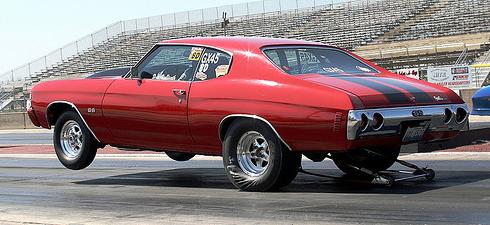No matter how much power the vehicle can produce, the total tire force (Ft), at a given speed v, cannot exceed the friction force available at the tires (Ff).
Maximum tractive force
(more)
*Note: The maximum value for Ft/m is the one found for an AWD (K1 = K2 = 1; see below). At that point, all the weight and downforce is acting on the rear axle and the vehicle is doing a «wheelie» as in the next figure.
Usually, once a wheelie is initiated, the front axle will tend to drop back as the speed increases. Still, in some cases (motorcycles for example), it is possible to keep the front axle off the ground if the equilibrium point is met.

Top speed
(more)
| vmax = |
|
√
|
|
|
| 0.5ρ |
[ |
CDA + |
( |
K2 μ − fr |
) |
CLA |
] |
|
|
|
|
(2) |
Where:
For an AWD: |
K1 = 1 |
K2 = 1 |
For a RWD: |
K1 =
|
K2 =
|
For a FWD: |
K1 =
|
K2 =
|
And:
